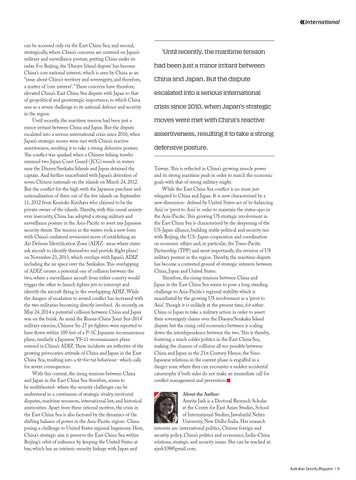International
can be accessed only via the East China Sea; and second, strategically, where China’s concerns are centered on Japan’s military and surveillance posture, putting China under its radar. For Beijing, the ‘Diaoyu Island dispute’ has become China’s core national interest, which is seen by China as an “issue about China’s territory and sovereignty, and therefore, a matter of ‘core interest’.” These concerns have therefore, elevated China’s East China Sea dispute with Japan to that of geopolitical and geostrategic importance, to which China sees as a severe challenge to its national defence and security in the region. Until recently, the maritime tension had been just a minor irritant between China and Japan. But the dispute escalated into a serious international crisis since 2010, when Japan’s strategic moves were met with China’s reactive assertiveness, resulting it to take a strong defensive posture. The conflict was sparked when a Chinese fishing trawler rammed two Japan Coast Guard ( JCG) vessels in waters near the Diaoyu/Senkaku Islands and Japan detained the captain. And further exacerbated with Japan’s detention of seven Chinese nationals on the islands on March 24, 2012. But the conflict hit the high with the Japanese purchase and nationalization of three out of the five islands on September 11, 2012 from Kunioko Kurihara who claimed to be the private owner of the islands. Thereby, with this causal anxiety over insecurity, China has adopted a strong military and surveillance posture in the Asia-Pacific to avert any Japanese security threat. The tension in the waters took a new form with China’s unilateral revisionist move of establishing an Air Defense Identification Zone (ADIZ- areas where states ask aircraft to identify themselves and provide flight plans) on November 23, 2013, which overlaps with Japan’s ADIZ including the air space over the Senkakus. This overlapping of ADIZ creates a potential one of collision between the two, where a surveillance aircraft from either country would trigger the other to launch fighter jets to intercept and identify the aircraft flying in the overlapping ADIZ. While the dangers of escalation to armed conflict has increased with the two militaries becoming directly involved. As recently, on May 24, 2014 a potential collision between China and Japan was on the brink. As amid the Russia-China ‘Joint Sea-2014’ military exercise, Chinese Su-27 jet fighters were reported to have flown within 100 feet of a P-3C Japanese reconnaissance plane, similarly a Japanese YS-11 reconnaissance plane entered in China’s ADIZ. These incidents are reflective of the growing provocative attitude of China and Japan in the East China Sea, resulting into a tit-for-tat behaviour- which calls for severe consequences. With this context, the rising tensions between China and Japan in the East China Sea therefore, seems to be multifaceted- where the security challenges can be understood in a continuum of strategic rivalry, territorial disputes, maritime resources, international law, and historical animosities. Apart from these rational motives, the crisis in the East China Sea is also factored by the dynamics of the shifting balance of power in the Asia-Pacific region- China posing a challenge to United States regional hegemony. Here, China’s strategic aim is preserve the East China Sea within Beijing’s orbit of influence by keeping the United States at bay, which has an intrinsic security linkage with Japan and
‘Until recently, the maritime tension had been just a minor irritant between China and Japan. But the dispute escalated into a serious international crisis since 2010, when Japan’s strategic moves were met with China’s reactive assertiveness, resulting it to take a strong defensive posture. Taiwan. This is reflected in China’s growing muscle power and its strong maritime push in order to match the economic goals with that of strong military might. While the East China Sea conflict is no more just relegated to China and Japan. It is now characterised by a new dimension- defined by United States act of ‘re-balancing Asia’ or ‘pivot to Asia’ in order to maintain the status-quo in the Asia-Pacific. This growing US strategic involvement in the East China Sea is characterised by the deepening of the US-Japan alliance, building stable political and security ties with Beijing, the U.S.-Japan cooperation and coordination on economic affairs and, in particular, the Trans-Pacific Partnership (TPP) and most importantly, the revision of US military posture in the region. Thereby, the maritime dispute has become a contested ground of strategic interests between China, Japan and United States. Therefore, the rising tensions between China and Japan in the East China Sea seems to pose a long standing challenge to Asia-Pacific’s regional stability which is exacerbated by the growing US involvement as a ‘pivot to Asia’. Though it is unlikely at the present time, for either China or Japan to take a military action in order to assert their sovereignty claims over the Diaoyu/Senkaku Island dispute but the rising cold economics between is scaling down the interdependence between the two. This is thereby, fostering a much colder politics in the East China Sea, making the chances of collision all too possible between China and Japan in the 21st Century. Hence, the SinoJapanese relations in the current phase is engulfed in a danger zone where they can encounter a sudden accidental catastrophe if both sides do not make an immediate call for conflict management and prevention. About the Author: Amrita Jash is a Doctoral Research Scholar at the Centre for East Asian Studies, School of International Studies, Jawaharlal Nehru University, New Delhi-India. Her research interests are: international politics, Chinese foreign and security policy, China’s politics and economics, India-China relations, strategic and security issues. She can be reached at: ajash108@gmail.com.
Australian Security Magazine | 9
